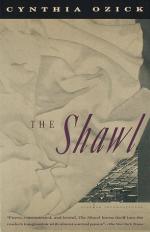|
This section contains 711 words (approx. 3 pages at 300 words per page) |

|
SOURCE: Hattenhauer, Darryl, Shay McCool, and P. K. McMahon. “Ozick's The Shawl.” The Explicator 57, no. 4 (summer 1999): 238-9.
In the following essay, Hattenhauer, McCool, and McMahon, in a close reading of the “The Shawl”'s conclusion, suggest that a complex reading is more appropriate than a simplistic one.
Critics have pondered the indeterminate plot resolution of Cynthia Ozick's “The Shawl,” which ends with a Nazi throwing an infant onto an electrified fence. Many critics contend that the murder is affirmative because the infant's death somehow surmounts the suffering of the Holocaust—that her death saves the infant Magda from further suffering, or that her death delivers others from suffering. For example Amy Gottfried claims that Ozick “grants the most powerless of victims a final moment of transcendence […]” (42).
Indeed, some of the air imagery suggests transcendence. Rosa, Magda's mother, seems like an angel. She feels “light, like someone in a...
|
This section contains 711 words (approx. 3 pages at 300 words per page) |

|


